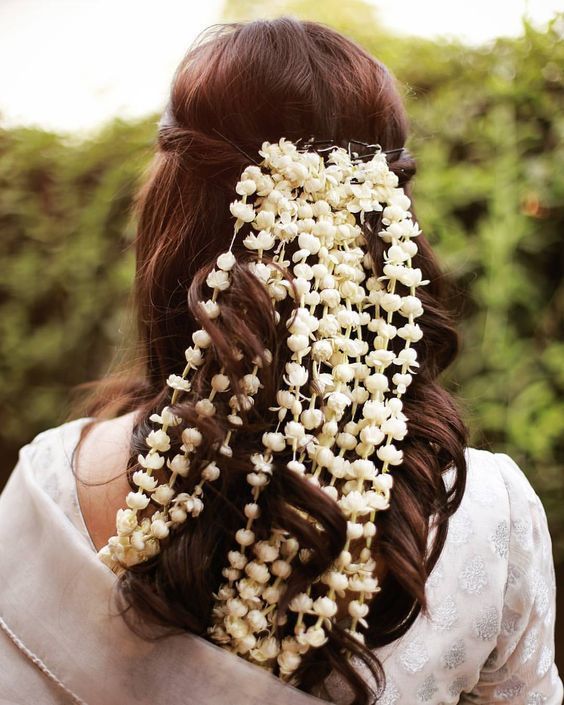Women frequently wear gajra, a traditional Indian ornament, especially during ceremonial occasions and cultural gatherings. It is a gorgeous and fragrant hair accessory that is made out of a garland or string of flowers that have been expertly woven together.
In Indian traditions, the gajra has have great cultural and artistic value. Fresh flowers with a lovely scent, such as tuberose, marigolds, jasmine, or roses, are frequently used to make them. A delicate and enticing item is made by carefully choosing the flowers and stringing them in a circular or linear design.
Wearing a gajra enhances Indian women's outfits with a touch of heritage and beauty, whether it is for a wedding, festival, or another special occasion. It is a classic ornament with a specific position in Indian culture that reflects the nation's rich heritage and artistic sensibility.
Origin and Cultural Significance:
The gajra's origins can be traced back to ancient India when it was incorporated into festivities, rituals, and folklore. In the past, the gajra was connected to happy occasions like weddings, festivals, and religious rituals. The gajra was an essential part of ceremonies and festivities because it was thought that the subtle aroma of the flowers in it would conjure up good energy.
Materials and Flowers Used:
Gajras are is meticulously crafted using a variety of fragrant flowers, each lending its unique charm and aroma. Jasmine, known as the queen of flowers, is a popular choice for gajras due to its intoxicating scent and delicate white blooms.
Rose, tuberose, marigold, and mogra (jasmine sambac) are other commonly used flowers, each adding their distinct colours and fragrances to the garland. The choice of flowers often depends on personal preference, regional customs, and the occasion.
Art of Making Gajras:
Making gajras is a skill that has been passed down through the generations. The garland is kept intact and the flowers stay fresh thanks to the skilled artisans who use a tiny thread to weave the blooms together. Each flower is arranged with care to create a visually appealing pattern, requiring accuracy and a light touch. Since traditional methods and knowledge are still being used today, craftsmanship can flourish despite the world's rapid change.
The versatility of Gajras:
Gajras have developed into adaptable accessories that can be worn in a variety of ways while being typically worn in the hair. They can be worn as anklets, bracelets, or even necklaces to give a touch of class to any outfit.
Gajras in Modern Times:
Gajras have survived changing fashion fads while yet retaining their classic appeal. Gajras has resurfaced as a preferred option among brides in recent years, giving a touch of traditionalism to their wedding clothing. Incorporating the gajra into their modern styles, celebrities and fashion aficionados have also embraced it, bridging the gap between heritage and modernity.
Beauty that Lasts:
The longevity of artificial gajras is one of its main advantages. Real flowers wilt within a few hours or days, but artificial gajras keep their appeal and freshness for a longer time. Because of their toughness, people can wear them again without worrying that they will wilt or wither. Artificial gajras provide enduring beauty that improves the entire appearance during weddings, festivals, and other important events.
Eco-Friendly and Sustainable:
Using genuine flowers for gajras influences the environment. It frequently entails intensive farming, movement, and pesticide use. Artificial gajras, on the other hand, aid in easing these worries. By choosing artificial gajras, people help promote sustainable practices by producing less trash and using fewer natural resources. Additionally, since fake gajras can be utilised again, they reduce the need for fresh flowers and ease environmental stress.
Types of gajra:
A gajra is a traditional Indian accessory typically worn by women in their hair. It is created by stringing together flowers, typically rose, marigold, or jasmine, to create an arrangement that resembles a garland. A fragrant and aesthetically pleasing accessory is made by weaving the blooms closely together.

Jasmine flowers are commonly used to make gajras due to their delicate white petals and sweet fragrance. Jasmine gajras are highly popular and are often worn during festivals, weddings, and other special occasions.

Roses are another popular choice for gajras. They come in various colors like red, pink, yellow, and white, and can be mixed with other flowers or worn alone. Rose gajras add elegance and beauty to any hairstyle.

Bright marigold flowers are frequently used to construct gajras. They have a cheery appearance and come in yellow and orange tones, making them ideal for festive occasions and celebrations.

The incredibly fragrant flower mogra, also known as Arabian jasmine, is frequently used in gajras. It smells strongly of sugar and has tiny white petals. Traditional Indian marriages frequently use mogra gajras as their wedding attire.
Tube Rose Gajra:

Tube rose, also called Rajnigandha, is a flower known for its pleasant fragrance. Its long, slender white flowers are commonly used to make gajras and add a touch of elegance to hairstyles.
Orchid Gajra:

Orchids are exotic flowers that come in a variety of colours and shapes. Orchid gajras are unique and add a modern twist to traditional hairstyles. They are often used for contemporary or fusion looks.
Lily Gajra:

Lilies are large, showy flowers that are occasionally used to make gajras. They are available in different colours and can make a statement when incorporated into a gajra design.
Conclusion:
The gajra epitomises Indian womanhood, heritage, and festivity. It has been a vital component of Indian culture for decades thanks to its delicate beauty and aromatic charm. The gajra never fails to fascinate and exude a feeling of timeless appeal, whether it is worn for weddings, festivals, or casual gatherings.
By passing it on to future generations, we make sure that this valued custom endures as we appreciate the creativity and significance of gajras.

